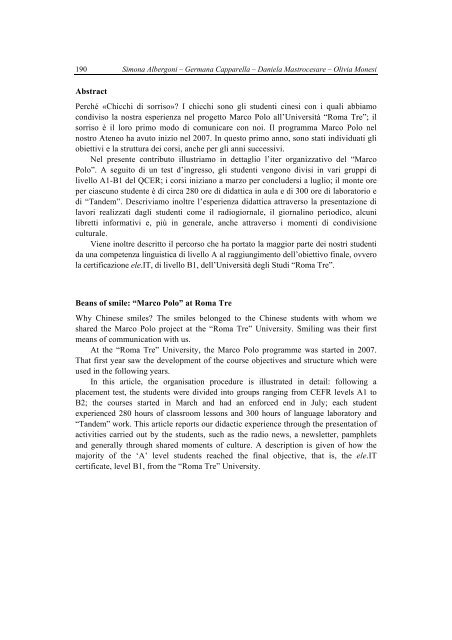La didattica dell'italiano a studenti cinesi e il progetto Marco Polo ...
La didattica dell'italiano a studenti cinesi e il progetto Marco Polo ...
La didattica dell'italiano a studenti cinesi e il progetto Marco Polo ...
Create successful ePaper yourself
Turn your PDF publications into a flip-book with our unique Google optimized e-Paper software.
190<br />
Abstract<br />
Simona Albergoni – Germana Capparella – Daniela Mastrocesare – Olivia Monesi<br />
Perché «Chicchi di sorriso»? I chicchi sono gli <strong>studenti</strong> <strong>cinesi</strong> con i quali abbiamo<br />
condiviso la nostra esperienza nel <strong>progetto</strong> <strong>Marco</strong> <strong>Polo</strong> all’Università “Roma Tre”; <strong>il</strong><br />
sorriso è <strong>il</strong> loro primo modo di comunicare con noi. Il programma <strong>Marco</strong> <strong>Polo</strong> nel<br />
nostro Ateneo ha avuto inizio nel 2007. In questo primo anno, sono stati individuati gli<br />
obiettivi e la struttura dei corsi, anche per gli anni successivi.<br />
Nel presente contributo <strong>il</strong>lustriamo in dettaglio l’iter organizzativo del “<strong>Marco</strong><br />
<strong>Polo</strong>”. A seguito di un test d’ingresso, gli <strong>studenti</strong> vengono divisi in vari gruppi di<br />
livello A1-B1 del QCER; i corsi iniziano a marzo per concludersi a luglio; <strong>il</strong> monte ore<br />
per ciascuno studente è di circa 280 ore di <strong>didattica</strong> in aula e di 300 ore di laboratorio e<br />
di “Tandem”. Descriviamo inoltre l’esperienza <strong>didattica</strong> attraverso la presentazione di<br />
lavori realizzati dagli <strong>studenti</strong> come <strong>il</strong> radiogiornale, <strong>il</strong> giornalino periodico, alcuni<br />
libretti informativi e, più in generale, anche attraverso i momenti di condivisione<br />
culturale.<br />
Viene inoltre descritto <strong>il</strong> percorso che ha portato la maggior parte dei nostri <strong>studenti</strong><br />
da una competenza linguistica di livello A al raggiungimento dell’obiettivo finale, ovvero<br />
la certificazione ele.IT, di livello B1, dell’Università degli Studi “Roma Tre”.<br />
Beans of sm<strong>il</strong>e: “<strong>Marco</strong> <strong>Polo</strong>” at Roma Tre<br />
Why Chinese sm<strong>il</strong>es? The sm<strong>il</strong>es belonged to the Chinese students with whom we<br />
shared the <strong>Marco</strong> <strong>Polo</strong> project at the “Roma Tre” University. Sm<strong>il</strong>ing was their first<br />
means of communication with us.<br />
At the “Roma Tre” University, the <strong>Marco</strong> <strong>Polo</strong> programme was started in 2007.<br />
That first year saw the development of the course objectives and structure which were<br />
used in the following years.<br />
In this article, the organisation procedure is <strong>il</strong>lustrated in deta<strong>il</strong>: following a<br />
placement test, the students were divided into groups ranging from CEFR levels A1 to<br />
B2; the courses started in March and had an enforced end in July; each student<br />
experienced 280 hours of classroom lessons and 300 hours of language laboratory and<br />
“Tandem” work. This article reports our didactic experience through the presentation of<br />
activities carried out by the students, such as the radio news, a newsletter, pamphlets<br />
and generally through shared moments of culture. A description is given of how the<br />
majority of the ‘A’ level students reached the final objective, that is, the ele.IT<br />
certificate, level B1, from the “Roma Tre” University.

















